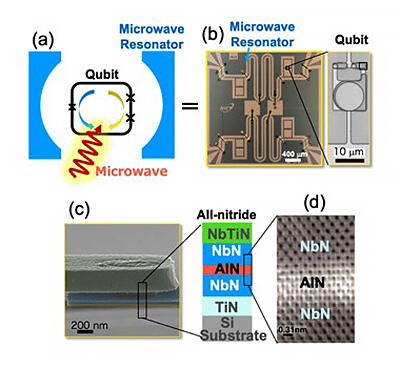The National Institute of Information and Communications Technology (NICT), in collaboration with the National Institute of Advanced Industrial Science and Technology and Nagoya University, has succeeded in developing the world's first nitride superconducting qubit epitaxially grown on silicon substrates. These are the first superconducting qubits that do not use aluminum as the superconducting material. Using niobium nitride as a superconductor makes it possible to construct a superconducting quantum circuit that operates stably. This is expected to contribute to the development of quantum computers and quantum nodes as basic elements of quantum computation. In the future, the group will work on optimizing the circuit structure and fabrication process and continue research and development to further extend the coherence time and achieve large-scale integration.
As superconducting qubits are solid-state devices, they exhibit excellent design flexibility, integrability, and expandability. However, they are easily affected by various disturbances surrounding them, and extending the coherence time, which is the lifetime of the quantum superposition state, is an issue. To overcome this challenge, research institutes around the world are primarily attempting to use aluminum (Al) and aluminum oxide (AlOx) as superconducting qubit materials. However, as there is a concern that amorphous aluminum oxide, which is often used as an insulating layer, may be a noise source, it is important to study other materials that can address this problem.
Therefore, as an alternative to aluminum and amorphous aluminum oxide with a superconducting transition temperature of 1 K (-272 °C), NICT has focused on using niobium nitride (NbN) with a superconducting transition temperature of 16 K (-257 °C) and an aluminum nitride (AlN) insulating film crystallized by the epitaxial growth method. NICT has also been developing superconducting qubits using all-nitride NbN/AlN/NbN junctions with NbN as the electrode material and AlN as the insulating layer of the Josephson junction. However, in order to realize a NbN/AlN/NbN junction (epitaxial junction) in which the crystal orientation is aligned with the upper electrode, it is necessary to use a magnesium oxide (MgO) substrate having a relatively similar crystal lattice constant to NbN. As MgO has a large dielectric loss, the coherence time of the superconducting qubit using an NbN/AlN/NbN junction on an MgO substrate is only approximately 0.5 μs. In contrast, the newly developed qubit is an all-nitride element epitaxially grown using niobium nitride (NbN) as the superconductor and electrode material, with a superconducting transition temperature of 16 K, and aluminum nitride (AlN) as the insulating layer of the Josephson junction. This is a new type of qubit composed of a superconducting material that does not contain amorphous oxide, which is a noise source.
By realizing a qubit of this new material on a silicon substrate, a coherence time with an average energy relaxation time (T1) of 16 μs and a phase relaxation time (T2) of 22 μs was obtained. T1 is approximately 32 times longer and T2 is approximately 44 times longer for this new qubit compared to nitride superconducting qubits on conventional magnesium oxide substrates.

(b) Optical micrograph of the nitride superconducting qubit circuit
(c) An electron micrograph of part of the nitride superconducting qubit and a cross-sectional view of the device
(d) Transmission electron micrograph of epitaxially grown nitride Josephson junction
Provided by NICT
The successful development of this nitride superconducting qubit is significant because it does not use conventional aluminum and aluminum oxide films for the Josephson junction, which is the heart of a superconducting qubit. It has a high superconducting transition temperature and exhibits excellent crystallinity due to epitaxial growth. In particular, the group successfully reduced the dielectric loss by epitaxial growth on a Si substrate and observed a coherence time of several tens of microseconds for a nitride superconducting qubit for the first time in the world. They also stated that the superconducting qubit of this nitride is still in its early stages of development and that there will be scope to further improve the coherence time by optimizing the design and fabrication process of the qubit in the future. Their achievement was published in Communications Materials, a specialized journal of the world-renowned publisher Nature Research, on September 20.
This article has been translated by JST with permission from The Science News Ltd.(https://sci-news.co.jp/). Unauthorized reproduction of the article and photographs is prohibited.




